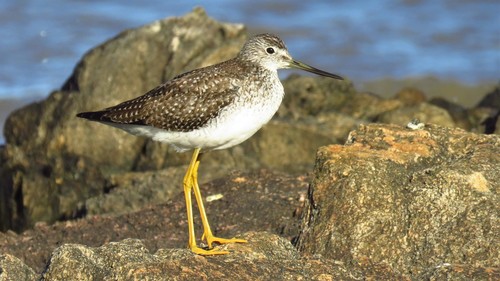
Greater Yellowlegs
The Greater Yellowlegs (Tringa melanoleuca) is a medium-sized shorebird known for its bright yellow legs and distinctive, ringing calls. It plays a crucial role in wetland ecosystems as both predator and prey, helping to regulate invertebrate populations and serving as a food source for larger predators. This species is a long-distance migrant, connecting breeding grounds in the boreal forests of North America with wintering areas that extend as far south as South America. While not currently considered globally threatened, it faces increasing pressures from habitat loss and climate change.
29-33 cm
Length
59-64 cm
Wingspan
Least Concern
Conservation Status
Distribution
Breeds across North America, from southern Alaska and Canada to Newfoundland. Migrates through Central America and the Caribbean. Winters along the coasts of the southern United States, Mexico, Central America, and South America, as far south as Tierra del Fuego. Altitudinal range varies from sea level to higher elevations during migration.
Lifespan
Average lifespan in the wild is estimated at 5-10 years, although some individuals may live longer.
Greater Yellowlegs's Habitat
Habitat Types
Coastal marshes, Mudflats, Estuaries, Freshwater wetlands, Riverbanks, Lakeshores
Climate Zones
Boreal, Temperate, Subtropical, Tropical
Adaptations
Long legs and bill allow foraging in deeper water than many other shorebirds. Slightly upturned bill aids in probing for invertebrates in mud and sand. They are strong fliers adapted for long-distance migration.
Variations
No recognized subspecies.
Appearance
Breeding Plumage
Breeding plumage is characterized by heavily streaked upperparts with black, brown, and white markings. Underparts are white with dark streaking on the breast and flanks. Non-breeding plumage is plainer, with grayer upperparts and less streaking on the underparts.
Seasonal Feather Changes
Plumage becomes more worn and faded towards the end of the breeding season. Molt into non-breeding plumage occurs after breeding.
Sex Based Plumage Differences
Males and females have similar plumage, although females may be slightly less boldly marked.
Notable Features
Bright yellow legs, Long, slightly upturned bill, White rump and tail with dark barring, White eye-ring
Diet and Feeding
Primary Foods
Small fish, Aquatic invertebrates, Crustaceans, Insects, Mollusks
Foraging Behavior
Actively probes in mud and shallow water with its bill. Often runs or walks quickly while foraging. May also pick prey from the water's surface or chase fish in shallow water.
Specializations
The slightly upturned bill is well-suited for probing in soft substrates. Long legs allow it to wade in relatively deep water.
Seasonal Diet Variations
Diet may shift slightly depending on prey availability. During migration and winter, may consume more crustaceans and mollusks. On breeding grounds, insects may form a larger part of the diet.
Behavior
Social Structure
Generally solitary or in small groups during the breeding season. Forms larger flocks during migration and winter.
Communication
Loud, ringing 'tew-tew-tew' call, Softer 'kip' notes, Alarm calls when threatened
Migration
Long-distance migrant. Travels in stages, stopping at suitable wetlands to refuel. Migration routes are often coastal but can also occur inland.
Territorial or Group Behaviors
Territorial during the breeding season, defending nesting areas from other Greater Yellowlegs. In non-breeding areas, may defend feeding territories, but often forages in loose flocks.
Conservation
Threats
Habitat loss and degradation (wetland drainage, coastal development), Pollution (pesticides, heavy metals), Climate change (sea-level rise, altered precipitation patterns), Human disturbance
Protection Programs
Migratory Bird Treaty Act (US and Canada), Western Hemisphere Shorebird Reserve Network (WHSRN), Various regional and local conservation initiatives
Local National Laws
Protected under federal laws in the US and Canada, as well as various state and provincial regulations.
Population Trend
Stable
Population Estimates
The global population is estimated to be around 300,000 individuals.
Interesting Facts
They are known for their 'bobbing' behavior.
Greater Yellowlegs frequently bob their heads and bodies up and down, especially when agitated or alert.
They can swim.
While primarily wading birds, Greater Yellowlegs can swim when necessary, particularly as chicks.
Their calls are often used to identify them.
The distinctive, ringing calls are a key identification feature, even when the bird is not clearly seen.
Faqs about Greater Yellowlegs
What is the difference between Greater and Lesser Yellowlegs?
Greater Yellowlegs are larger, have a longer, slightly upturned bill, and their calls are more ringing and typically three or more notes. Lesser Yellowlegs are smaller, have a shorter, straighter bill, and their calls are softer and usually one or two notes.
Where can I see Greater Yellowlegs?
Look for them in wetlands, mudflats, and along shorelines during migration and in winter. Check local birding reports for recent sightings.
Are Greater Yellowlegs endangered?
No, they are currently classified as Least Concern by the IUCN. However, they face threats from habitat loss and climate change, so their populations should be monitored.
Do Greater Yellowlegs eat seeds?
While their main diet is insects, crustaceans, mollusks and small fish, they can occasionally eat seeds
Copyright @ Nature Style Limited. All Rights Reserved.
 English
English